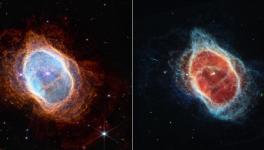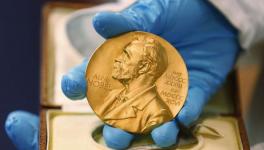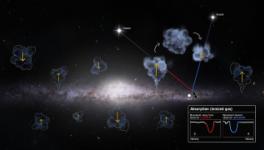Cosmic Candy Cane Near Milky Way’s Core Observed by NASA

Image Courtesy: NASA Goddard Space Flight Center.
In a latest, NASA scientists have observed an unusual scene within the central zone of the Milky Way—a bizarre dense cluster of gas clouds has taken the shape of a gigantic cosmic candy cane. The cosmic candy cane has the raw material that can generate millions of new stars, the scientists believe. For this reason, the observation is thought to provide scientists new aspects to understand how galaxies form stars.
But this is not a cosmic confection. The candy cane is estimated to span 190 light years and it is primarily a set of long thin strands of ionized gas called filaments emitting radio waves.
The image of the cosmic giant was captured by NASA’s Goddard-IRAM superconducting 2-millimeter Observer (GISMO) camera. This was accompanied by a 30-meter radio telescope.
“We’re very intrigued by the beauty of this image; it’s exotic. When you look at it, you feel like you’re looking at some really special forces of nature in the universe,” said Johannes Staguhn of Johns Hopkins University, who is one of the authors of the paper describing the image. The paper was published in The Astrophysical Journal.
“Our solar system is a small part of the Milky Way galaxy, a collection of stars, gas and dust bound together by gravity and named for its appearance from Earth as a milky band of light in the sky,” according to NASA.
Staguhn further said, “There’s a good chance that a significant part of star formation that occurred during the universe’s infancy is obscured and can’t be detected by tools we’ve been using, and GISMO will be able to help detect what was previously unobservable”.
The image also could identify several key features—there exists one feature called the sickle that is associated with the formation of stars. Then there is Sagittarius A, which is a region about 27,000 light years away from us and is an extremely bright red-yellow region. The Radio Arc, the bright red curve cuts through the sickle forming the straight part of the cosmic candy cane.
The filaments and its location and shapes also give clue about the history of our galaxy. Some filaments that are formed at the edges of a bubble were blown by some powerful event at the galaxy’s centre within Sagittarius A. The Milky Way’s supermassive black hole is also hosted here.
Previously, it was believed that star formation in the central region of the galaxy was continuous over the course of its history. But the new data say that at the very beginning of the galaxy, the central region had the formation of almost 80% of the stars.
Get the latest reports & analysis with people's perspective on Protests, movements & deep analytical videos, discussions of the current affairs in your Telegram app. Subscribe to NewsClick's Telegram channel & get Real-Time updates on stories, as they get published on our website.

















